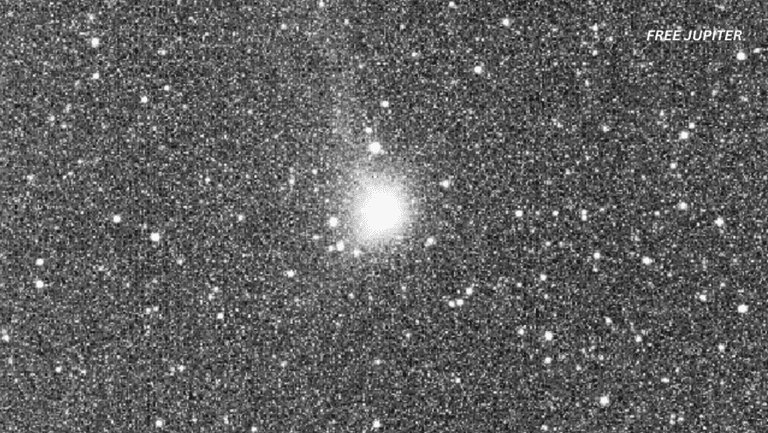Friendly Note: FreeJupiter.com shares general info for curious minds 🌟 Please fact-check all claims—and always check health matters with a professional 💙
June 2025 is shaping up to be an unforgettable month for anyone who enjoys looking up after sunset. From brilliant planetary displays to meteor showers and star clusters, the night sky will be alive with activity. Whether you’re a seasoned astronomer or just someone who likes to stargaze from your backyard, this month is packed with cosmic sights that promise to delight, surprise, and maybe even inspire a little awe.
Venus Shines Brightest in the Morning – June 1
The month begins with Venus putting on a show as it reaches its greatest western elongation on June 1. This is when Venus appears farthest from the Sun in the morning sky, making it especially easy to spot before sunrise. For observers in the northern hemisphere, look to the eastern sky just before dawn; in the southern hemisphere, Venus will be visible in the northeast. The planet will shine at a brilliant magnitude of -4.4, outshining everything except the Moon and the Sun, and offering an ideal opportunity for both casual skywatchers and those with telescopes to catch its dazzling presence.
Moon Meets Mars and Regulus – June 1 and June 17
On the evening of June 1, the Moon, in a waxing phase, will appear close to Mars in the constellation Leo. Mars, with its distinct reddish hue, will be about 1.2 magnitude, making it an easy target for the naked eye. The Moon and Mars will be separated by just over a degree, creating a striking pairing that’s perfect for binoculars or small telescopes.
Later in the month, on June 17, Mars will have a close encounter with Regulus, Leo’s brightest star. This pairing brings together the red planet and the blue-white “little king” star, forming a colorful duo in the evening sky. Regulus is often occulted by the Moon or planets, but on this night, it will simply shine side by side with Mars, making for a memorable sight.
Read more: Astronomers Are Baffled by a Space Object Flashing in Both Radio Waves and X-Rays
The Hercules Cluster at Its Highest – June 2
June 2 brings the Hercules Star Cluster, also known as Messier 13, to its highest point in the night sky. This globular cluster contains more than 100,000 stars packed into a spherical shape, and while it’s faint to the unaided eye, binoculars or a small telescope reveal a sparkling orb. M13 is one of the most impressive star clusters visible from Earth and was first cataloged in the early 18th century. This is an excellent night to try spotting it, especially from dark-sky locations.
Daytime Meteors: The Arietids Peak – June 7
Not all meteor showers are best seen at night. The Arietid meteor shower, which peaks around June 7, is unusual because most of its activity occurs during daylight hours. While the bright sky makes these meteors hard to spot, early risers might catch a few just before sunrise. For those who want to track the shower in real time, digital tools and meteor tracking apps can offer a virtual experience of this elusive event.
The Full Moon of June: The Berry Moon – June 11
June’s full moon, known as the Berry Moon, will light up the sky on June 11. The name comes from early summer traditions, as this is when wild strawberries ripen in North America. While the moon itself won’t appear red, it will be especially bright and prominent. In various cultures, it’s also called the Honey Moon or Mead Moon, names that reflect the season’s agricultural and celebratory traditions. This is a wonderful night for moonlit walks or simply enjoying the view.
Jupiter and Mercury’s Close Approach – June 8
On June 8, Jupiter and Mercury will appear close together in the constellation Taurus. Mercury, usually tricky to spot, will be at its brightest at magnitude -1.2, while Jupiter will shine at -1.9. The two planets will be just under two degrees apart, making this a great chance to see both in the same field of view through binoculars. Look low in the northwest shortly after sunset for the best view.
Moon and Antares – June 10
The Moon will pass near Antares, the heart of the constellation Scorpius, on June 10. Antares is a red supergiant star and one of the brightest in the night sky. With the Moon nearly full and just 0.3 degrees away from Antares, the pairing will be easy to spot with the naked eye or binoculars, offering a dramatic sight in the southern sky.
The June Solstice – June 21
June 21 marks the solstice, the astronomical start of summer in the northern hemisphere and winter in the southern hemisphere. On this day, the Sun reaches its highest point in the sky for northern observers, resulting in the longest day and shortest night of the year. Conversely, those in the southern hemisphere experience the shortest day and longest night. This is a pivotal moment in the astronomical calendar and a great reason to celebrate the changing seasons.
Read more: Scientists Warn, One of World’s Supervolcanoes is Waking Up: ‘It Will Plunge The Planet Into Chaos’
Lagoon Nebula at Its Best – June 22
The Lagoon Nebula, or Messier 8, will reach its highest point in the sky on June 22. This vast star-forming region, located about 5,200 light-years away in the constellation Sagittarius, is a favorite target for astrophotographers and those with telescopes. Under dark skies, the nebula can sometimes be glimpsed with the naked eye as a faint patch, but binoculars or a telescope will reveal its glowing gas clouds and young stars. The Lagoon Nebula sits near the heart of the Milky Way, making this a prime time to explore the galaxy’s core.
New Moon: Stargazing Opportunity – June 25
A new moon on June 25 means the sky will be especially dark, providing perfect conditions for observing faint objects like distant galaxies, nebulae, and the Milky Way’s core. With no moonlight to wash out the stars, this is the best time of the month for deep-sky observing and astrophotography. The Milky Way will be particularly prominent in the summer sky, stretching across the horizon and revealing its intricate structure to those with clear, dark skies.
Bootid Meteor Shower – June 27
The Bootid meteor shower is known for its unpredictability. Some years, it produces only a few meteors per hour; in others, it can be a real spectacle. The shower peaks on June 27, and with the Moon in a waxing crescent phase, its dim light won’t overpower the faint shooting stars. The Bootids radiate from the constellation Bootes and are best seen after midnight. Keep an eye out for slow-moving meteors that can sometimes leave persistent trails.
Moon and Mercury – June 27
On the same night as the Bootid meteor shower, the Moon will pass near Mercury in the constellation Cancer. Mercury will be at magnitude 0.2, and the Moon will be just 5% illuminated, making for a subtle but beautiful pairing low in the western sky after sunset. Binoculars will help you spot the tiny planet next to the slender crescent Moon.
Moon and Mars: A Close Encounter – June 30
June wraps up with a dramatic close approach between the Moon and Mars on June 30. The Moon, about one-third illuminated, will pass just 0.2 degrees from Mars, making it possible to see both in a single binocular field. In some regions, the Moon will actually pass in front of Mars, an event known as a lunar occultation. Even if you’re not in the path of the occultation, the close pairing will be a highlight of the month’s skywatching events.
Planets on Display: June’s Planetary Parade
- Venus: The “Morning Star” dominates the dawn sky all month, shining at magnitude -4.4 to -4.2. Look east before sunrise for its unmistakable brilliance.
- Mars: Visible in the evening, moving through Leo, but gradually setting earlier as the month progresses. Its brightness fades slightly from magnitude 1.3 to 1.5.
- Mercury: Best seen in the evening sky during mid to late June, especially after sunset. Its brightness decreases but visibility improves as it climbs higher above the horizon.
- Jupiter: Difficult to observe this month as it approaches conjunction with the Sun on June 24. It’s low in the northwest at dusk and quickly lost in the Sun’s glare.
- Saturn: Rises in the eastern sky before dawn, gradually becoming more prominent as the month goes on. It dims slightly from magnitude 1.1 to 1.0.
- Uranus and Neptune: Both are visible in the morning sky, but require binoculars or a telescope due to their faintness.
Constellations and the Milky Way
June is also a great time to explore the constellations. In the northern hemisphere, Scorpius, Ophiuchus, Libra, Virgo, and Leo are prominent after sunset. The jewel of the summer sky, Cygnus, rises in the northeast as the night progresses. In the southern hemisphere, Sagittarius and the center of the Milky Way are well-placed for observation, offering rich star fields and nebulae for those with binoculars or telescopes.
Read more: Scientists Warn That ‘Invisible’ Asteroids Could Be Heading for Earth
Tips for Observing June’s Night Sky
- Find a location away from city lights for the best views.
- Use binoculars or a small telescope to enhance your experience, especially for star clusters and nebulae.
- Check local times for moonrise, moonset, and the timing of each event, as these can vary by location.
- Bring a star chart or use a stargazing app to help identify planets, stars, and constellations.
Final Thoughts
June 2025 offers a cosmic calendar packed with variety and wonder. From the brilliance of Venus and the full Berry Moon to meteor showers and rare planetary pairings, each night brings something new to discover. Whether you’re an early riser catching Venus at dawn or a night owl watching meteors streak across the sky, this month is a reminder of the beauty and mystery that awaits above. So grab your binoculars, set your alarm, and prepare for a month of unforgettable stargazing adventures.










